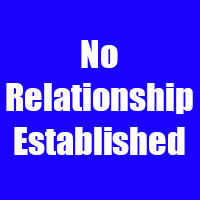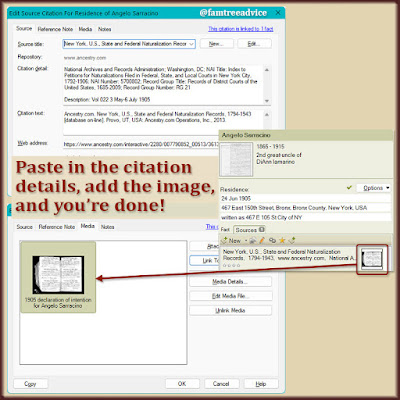One morning I had the idea of "finishing" one family unit in my tree at a time. Finishing them means locating and adding every document I know is missing. I thought I'd take a look at the hints on Ancestry.com and compare them to what my Document Tracker says I'm missing.
The first family in my alphabetical Document Tracker is the Abbate family. I found the 1898 marriage certificate for Francesco and Mary Abbate I'd been missing. It gave me their parents' names and their Manhattan addresses. I added the certificate image and its source citation to all the associated facts. I added "1898 (cert.)" to the marriage column of my Document Tracker for both Francesco and Mary. That tells me I have the certificate image in my family tree.
But Francesco Abbate is the father-in-law of the 1st cousin once removed of the wife of my 1st cousin! No offense to my 1st cousin's lovely wife, but I'd like to spend this effort a little closer to home.
I wondered how many families were in my enormous family tree. When I opened my latest GEDCOM file in Family Tree Analyzer, it said I have:
- 46,600 individuals
- 15,472 families
- 9,587 blood relations
Woof! Where do I start? The answer has to be with my parents. I know I downloaded their 1950 censuses, but I haven't added them to my tree yet. What else can I find for them before moving on to their parents?
 |
| If you focus on one document-type at a time, you'll be more efficient and consistent in how you capture facts for your family tree. |
You may be wondering why on earth I haven't added their 1950 censuses to my family tree. When they released the census, but Ancestry hadn't yet indexed it, I downloaded 44 images. Then I held them until I could use Ancestry's source citation and link. I haven't gotten back to it yet, but the images are ready and waiting for me.
A Generation-at-a-Time Process
So let's start. Look at your parents. What documents and records can you still find that belong in your family tree?
- Do you have every census they appear in?
- Do you have birth, marriage, and death records?
- Do you have yearbooks and directories?
- Do you have key photos and mementos, such as a wedding invitation?
I tracked down my dad's 1950 census on Ancestry. I added a correction to the family's last name. It was off by one letter. Now I have the source citation I need for the document image I saved months ago. Dad was on line 2 of his census page, meaning they asked him extra questions at the bottom of the page. I learned that he was in his first year of college in 1950, and he was not working while he studied.
I love how specific this census is. It says his family lived at 562 Morris Avenue. But it also says they're on the 4th floor (which I knew) in apartment 16 (which I didn't know). I'm adding "4th floor, apartment 16" to the description line of the 1950 residence fact for my dad and his family.
Now my dad's 4-person family has their 1950 census images and source citation. I added the 1950 census to my Document Tracker for all 4 people.
Once you've finished your father, how will you proceed? You can stay in that generation and finish gathering your mother's documents. Then go up a generation, gathering everything for each of your grandparents. Will you spread out to gather documents for the siblings of each generation? How soon will this process spiral out of control? My mind is reeling already.
A More Manageable Process
Instead of plodding through every level of my family, one-by-one, I have another idea. What got me started on this whole project was a random hint featured on my Ancestry homepage. It was the immigration record for someone in my family tree.
I opened my Document Tracker with the idea of locating all my immigration records. That's what brought me to Francesco Abbate.
| An up-to-date document tracker is your best friend when trying to "finish" a family unit in your family tree. |
What if we pick one type of document and concentrate on nothing else? Don't you think that will be productive? When I look at the list of all my hints on Ancestry, there's a unique category for the 1950 census. I can click that to see only those hints and work my way through them.
You can sort this list of hints by last name or first name, or choose to see the most recent. If you sort by last name, you'll see families grouped together. That makes the most sense because you're going to pick off whole families at a time.
As you work your way down the list, be sure to add your new finds to your Document Tracker. As you do so, take a look in your tree at each person you're adding. Make note of which other documents you have for them, and which you're missing.
When you've finished locating one type of document, like the 1950 census, move on to another type. You can tackle:
- other census years
- immigration records
- naturalization papers
- vital records, and more.
Through repetition, you'll get better at creating source citations. You'll make a habit of adding new finds to your Document Tracker.
If you've been busy with a brick wall for a while, this project will make you feel great about your amazing progress.





